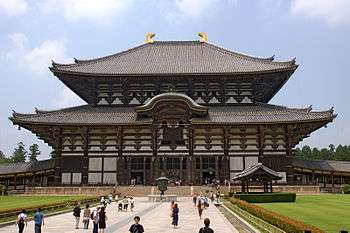Kegon
| Part of a series on |
| Buddhism |
|---|
 |
|
Kegon (華厳宗) is the Japanese transmission of the Huayan school of Chinese Buddhism.
Huayan studies were founded in Japan in 736 when the scholar-priest Rōben (良辯 or 良弁), originally a monk of the East Asian Yogācāra tradition, invited Shinshō (traditional Chinese: 審祥; ; pinyin: Shenxiang; Japanese pronunciation: Shinjō; Korean: Simsang) to give lectures on the Avatamsaka Sutra at Kinshōsen Temple (金鐘山寺, also 金鐘寺 Konshu-ji or Kinshō-ji), the origin of later Tōdai-ji. When the construction of the Tōdai-ji was completed, Rōben entered that temple to formally initiate Kegon as a field of study in Buddhism in Japan, and Kegon-shū would become known as one of the Nanto Rikushū (南都六宗) or Six Buddhist Sects of Nanto). Rōben's disciple Jitchū continued administration of Tōdai-ji and expanded its prestige through the introduction of imported rituals.
Kegon thought would later be popularized by Myōe (明惠), who combined its doctrines with those of Vajrayana and Gyōnen (凝然), and is most responsible for the establishment of the Tōdai-ji lineage of Kegon. Over time, Kegon incorporated esoteric ritual from Shingon Buddhism, with which it shared a cordial relationship. Its practice continues to this day, and includes a few temples overseas.
Literature
- Daigan Lee Matsunaga und Alicia Orloff Matsunaga: Foundation of Japanese Buddhism; Vol. I; The aristocratic age. Buddhist Books International, Los Angeles und Tokio 1974. ISBN 0-914910-25-6.
- Thomas Cleary (trans.): The Flower Ornament Scripture: A Translation of the Avatamsaka Sūtra (1993). ISBN 0-87773-940-4
- Gimello, Robert ; Girard, Frédéric ; Hamar, Imre (2012). Avataṃsaka Buddhism in East Asia : Huayan, Kegon, Flower Ornament Buddhism ; origins and adaptation of a visual culture, Asiatische Forschungen: Monographienreihe zur Geschichte, Kultur und Sprache der Völker Ost- u. Zentralasiens, Wiesbaden: Harrassowitz, ISBN 978-3-447-06678-5.
External links
- (Japanese) 華厳宗大本山 東大寺の公式ホームページ
